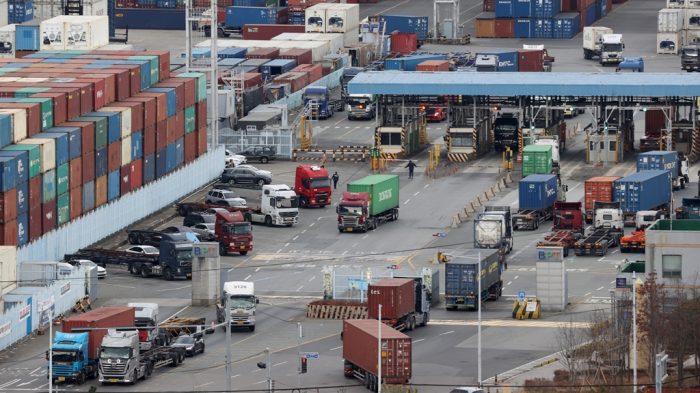Economy
S.Korea logs record trade deficit in 2022; outlook dim
Exports of Asia’s fourth-largest economy fall for third month in December 2022 as semiconductor sales drop for fifth straight month
By Jan 01, 2023 (Gmt+09:00)
2
Min read
Most Read
LG Chem to sell water filter business to Glenwood PE for $692 million


Kyobo Life poised to buy Japan’s SBI Group-owned savings bank


KT&G eyes overseas M&A after rejecting activist fund's offer


StockX in merger talks with Naver’s online reseller Kream


Mirae Asset to be named Korea Post’s core real estate fund operator



South Korea suffered a record trade deficit last year as the ongoing war in Ukraine ramped up energy import bills, while the outlook remained dark with exports down for the third month in a row on the falling overseas sales of semiconductors, the country’s top sales item.
The country reported a trade deficit of $47.2 billion in 2022, the Ministry of Trade, Industry and Energy said on Sunday. That was the first shortfall since 2008 when the country suffered from the global financial crisis.
Imports jumped 18.9% to $731.2 billion as energy resource procurements surged 69.8% to $190.8 billion with prices of both liquefied natural gas and coal more than doubling, according to data from the ministry. Purchases of commodities such as aluminum and copper, as well as components for industrial productions including semiconductors also advanced.
On the other hand, exports underperformed imports with a 6.1% growth as overseas sales fell in December 2022 for three consecutive months.
“Exports have been declining since October (last year) due to a global economic slowdown,” said Minister of Trade, Industry and Energy Lee Changyang in a statement. “The conditions for exports are likely to deteriorate in 2023 as the global downturn is expected to hurt growth in major economies.”
The expected sluggish exports are forecast to drag growth in Asia’s fourth-largest economy down to 1.7% in 2023 from an estimated 2.6% last year, the central bank said in November. The Bank of Korea had expected the local economy to expand by 2.1% in 2023 before.
FALLING CHIP EXPORTS
Exports in December dropped 9.5% to $55 billion from a year earlier after falling 14% and 5.8% in November and October, respectively.
Semiconductor exports, which made up 16.5% of the country’s total overseas sales in December, tumbled 29.1% on-year, extending their falling streak to a fifth straight month. South Korea is home to the world’s top two memory chipmakers – Samsung Electronics Co. and SK Hynix Inc.
The slump came as DRAM prices tumbled on rising inventory and demand for servers and consumer information technology products such as smartphones weakened, the ministry said.
Exports of petrochemicals and refined oil products skidded 23.8% and 22.7%, respectively, while overseas sales of displays tumbled 35.9%.
Sales to China, South Korea’s largest export market, slid for a seventh straight month by falling 27% on weaker shipments of semiconductors, petrochemicals and displays amid a downturn of the world’s second-largest economy.
Exports to Southeast Asia extended their falling streak to a third month as sales to the Association of Southeast Asian Nations (ASEAN) declined by 16.8%.
South Korea’s total imports in December eased 2.4% to $59.7 billion, resulting in a trade deficit of $4.7 billion. The country has been reporting such a shortfall since April last year, the longest deficit streak since the period from January 1995 to May 1997.
Write to So-Hyeon Kim at alpha@hankyung.com
Jongwoo Cheon edited this article.
More to Read
-
 EconomyKorea October current account surplus tumbles as exports slide
EconomyKorea October current account surplus tumbles as exports slideDec 09, 2022 (Gmt+09:00)
2 Min read -
 EconomyKorea inflation at 7-mth low; BOK may slow rate hike pace
EconomyKorea inflation at 7-mth low; BOK may slow rate hike paceDec 02, 2022 (Gmt+09:00)
2 Min read -
 EconomyKorea exports dip for 2nd month, growth slows to 1-year low
EconomyKorea exports dip for 2nd month, growth slows to 1-year lowDec 01, 2022 (Gmt+09:00)
3 Min read -
 Central bankBOK takes 25-bp rate hike as won rebounds against dollar
Central bankBOK takes 25-bp rate hike as won rebounds against dollarNov 24, 2022 (Gmt+09:00)
2 Min read
Comment 0
LOG IN


